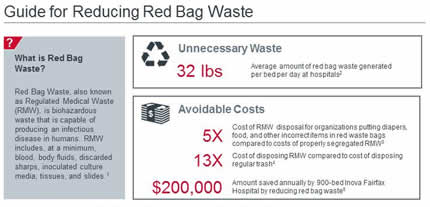In recent years, hospitals have made huge strides toward becoming more energy efficient and sustainable. In November, a Wisconsin health system became the first to create more energy than it consumes.
To get a better sense of what it takes to become more sustainable, the Daily Briefing's Juliette Mullin sat down with Supply Chain Services General Manager Zac Stillerman and Health Care Sustainability Initiative Director Joanna Schneider to talk about the important first steps and how environmental sustainability ties to huge cost savings for hospitals.
Question: Let's start at the beginning. Why should hospitals care about sustainability?

Zac Stillerman: Well, it's important to understand that environmental stewardship impacts both mission and margins. Hospitals contribute to environmental issues through pollution, resource consumption, and the use of toxic chemicals. These outputs ultimately damage the health of the populations that hospitals exist to serve.
Health care facilities also drive more than 8% of carbon emissions in the United States due to high demands for temperature control, ventilation, lighting, energy, and waste processing, all of which dramatically drive up costs. Better environmental stewardship results in more than healthier communities—it can also generate significant cost savings.
Q: How much can a hospital really save through more sustainable behavior? And what kinds of changes make an impact?
Joanna Schneider: We see how much hospitals can save through sustainability inside the Advisory Board membership. To share a few examples:
- Houston-based Memorial Hermann Health System implemented energy efficiencies and saved $47 million over five years.
- The UAMS Medical Center in Arkansas saved $300,000 over five years—enough to pay for three additional employees—solely through solid waste savings.
- Advocate Health Care, based in Chicago, has saved $3 million per year since 2008 through waste and energy initiatives and earned $250,000 in utility rebates.
Stillerman: I think these examples all show that healthier environments correlate with healthier patients, which further drives down costs. With investment in energy-efficient technology, renewable energy sources, and reusable supplies, hospitals can see six- or seven-figure ROIs over just a few years.
Q: If it’s so logical, why have more hospitals not prioritized sustainability?
Stillerman: Well the issue—which has always been important—is becoming a higher priority for hospitals.
Though leaders have long known the importance of environmental sustainability efforts, imminent priorities have historically pushed this work to the backburner. This lack of urgency, combined with a lack of clear ownership within the hospital, has allowed inertia to prevent major changes. But with growing research showing the drastic impact of health care facilities on climate change, an increasing demand for improvement in this area from patients and communities, and the negative impact of our changing environment on the health of our populations, improving the environmental footprint of the organization is becoming more important, and a key strategy for reducing costs.

Schneider: There's also the issue of ROI, which has now been proven. Countless institutions have seen huge returns on investments by improving their environmental footprint. From hiring staff dedicated to sustainability to green purchasing initiatives, it is clear that investing in the environment can help the bottom line.
Q: So if I'm an executive setting out to make my hospital more sustainable, what do I do first? What are some the low-hanging fruit in this space?
Schneider: We've found that success is all about starting small and proving outcomes. So you should tackle easy, low-cost opportunities first to start proving your sustainability ROI and building environmental stewardship into the hospital culture. Here are some simple steps to begin with:
Read about ten tactics for improving sustainability at your hospital
- Build your infrastructure. Establish a dedicated "green team" that can decide on tactics, implement changes, and establish incentives. One of our hospital members, an academic medical center on the East Coast, established a green team comprised of directors and above. The team was able to cut $30 million from the budget and later expand to include a second green team comprised exclusively of nurses and nursing executives.
- Choose where to start. One area we see having a huge impact is the reduction of regulated medical waste. This "red bag waste" (RBW) is energy-intensive and very expensive to process, costing up to 30 times more than recycling. Appropriate waste segregation will reduce a hospital’s carbon emissions and costs.
- Maximize recycling. Sticking with the waste theme, another key first step is making sure your hospital has a recycling program. If it doesn't, start one. If it does, set concrete goals to divert more solid waste to recycling. Look into recycling items that can bring in revenue, such as batteries, and high-volume items like blue wrap. Collect data from your waste vendor. Like RMW, recycling is better for the environment and less expensive to process. And it can even bring in revenue.
Q: You mentioned that sustainability is a community health issue too. Can you explain how one hospital's operations can affect the health of its community?
Stillerman: Hospitals are incredibly resource-intensive facilities, contributing significantly to the carbon dioxide emissions that have negative health impacts. For example, researchers have proven that the rise in carbon dioxide is tied to a rise in asthma and allergies.
Climate changes are bringing more allergies, asthma
As hospitals strive toward improving the health of their communities, clean air and clean water are essential. Hospitals now are realizing that they should try to minimize the release of toxins and greenhouse gasses into the communities they serve.
Q: What kind of resources can hospitals be turning to as they look to improve their sustainability efforts?
Stillerman: While ample research has shown the health and financial impacts of environmental sustainability, hospital leaders might not always know what to do with it.
In fact, it's an issue that we've been working on here at the Advisory Board, and the company is fully committed to helping our members identify and implement sustainable best practices to lower costs and improve population health. We are still early in our exploration of this area, but Joanna has been working with me and my team to build out a strategy that helps hospitals figure out where to start on a pro-bono basis.
How we can help you
- Check out our infographic on 10 “low-hanging fruit” opportunities to cash in on sustainability
- Use our 10 tactical briefs to learn about the cost savings, environmental impact, and action steps for each of these opportunities
- Read relevant research, articles, and blog posts on advisory.com/sustainability
- Our team of experts will work to answer your sustainability questions for free. Send any questions to sustainability@advisory.com
Don't miss out on the latest Advisory Board insights
Create your free account to access 2 resources each month, including the latest research and webinars.
Want access without creating an account?
You have 2 free members-only resources remaining this month remaining this month.
1 free members-only resources remaining this month
1 free members-only resources remaining this month
You've reached your limit of free monthly insights
Become a member to access all of Advisory Board's resources, events, and experts
Never miss out on the latest innovative health care content tailored to you.
Benefits include:
You've reached your limit of free monthly insights


